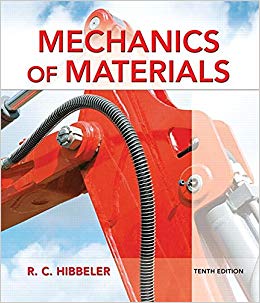The tie rods in the press in Figure 3-3 are made of the steel alloy AISI 5160 OQT 900. Each rod has a diameter of
The tie rods in the press in Figure 3-3 are made of the steel alloy AISI 5160 OQT 900. Each rod has a diameter of 2.00 in and an initial length of 68.5 in. An axial tensile load of 40 000 lb is exerted on each rod during operation of the press. Compute the deformation of the rods. Check also if the strength of the material is adequate. Solution Objective Compute the deformation of the tie rods. Given Rods are steel, AISI 5160 OQT 900; sy = 179 ksi, su = 196 ksi, 12% elongation Diameter = D = 2.00 in. Length = L = 68.5 in. Axial force = F = 40 000 lb. Analysis Equation (3-9) will be used to compute deformation. The stress in the rods must be checked to ensure that it is below the proportional limit and safe under repeated shock loading. Results Axial tensile stress: = F/A.
Therefore, the stress is well below the proportional limit. For shock loading in a ductile material, Table 3-2 recommends the following design stress. The percent elongation of 12% is in the ductile range. Because the actual expected stress is below the design stress, the bar should be safe. Axial deformation: Use Equation (3-9). All data are known except the modulus of elasticity, E. From the footnotes of Appendix A-14 we find E = 30 106 psi. Then, Let's solve the above problem with a different load as given below: Problem Case Load (lbs) Deformation (in) Guided Practice 45000 ? 1. What is the objective of the solution? 2. Which input is provided in the problem? 3. Which equations will be employed to develop the solution, i.e. provide the equations to obtain the solution? 4. What are the results?
Step by Step Solution
There are 3 Steps involved in it
Step: 1

See step-by-step solutions with expert insights and AI powered tools for academic success
Step: 2

Step: 3

Ace Your Homework with AI
Get the answers you need in no time with our AI-driven, step-by-step assistance
Get Started


